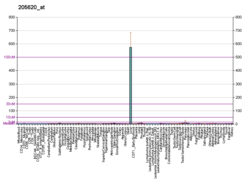1c5m: STRUCTURAL BASIS FOR SELECTIVITY OF A SMALL MOLECULE, S1-BINDING, SUB-MICROMOLAR INHIBITOR OF UROKINASE TYPE PLASMINOGEN ACTIVATOR
1ezq: CRYSTAL STRUCTURE OF HUMAN COAGULATION FACTOR XA COMPLEXED WITH RPR128515
1f0r: CRYSTAL STRUCTURE OF HUMAN COAGULATION FACTOR XA COMPLEXED WITH RPR208815
1f0s: Crystal Structure of Human Coagulation Factor XA Complexed with RPR208707
1fax: COAGULATION FACTOR XA INHIBITOR COMPLEX
1fjs: CRYSTAL STRUCTURE OF THE INHIBITOR ZK-807834 (CI-1031) COMPLEXED WITH FACTOR XA
1g2l: FACTOR XA INHIBITOR COMPLEX
1g2m: FACTOR XA INHIBITOR COMPLEX
1hcg: STRUCTURE OF HUMAN DES(1-45) FACTOR XA AT 2.2 ANGSTROMS RESOLUTION
1ioe: Human coagulation factor Xa in complex with M55532
1iqe: Human coagulation factor Xa in complex with M55590
1iqf: Human coagulation factor Xa in complex with M55165
1iqg: Human coagulation factor Xa in complex with M55159
1iqh: Human coagulation factor Xa in complex with M55143
1iqi: Human coagulation factor Xa in complex with M55125
1iqj: Human coagulation factor Xa in complex with M55124
1iqk: Human coagulation factor Xa in complex with M55113
1iql: Human coagulation factor Xa in complex with M54476
1iqm: Human coagulation factor Xa in complex with M54471
1iqn: Human coagulation factor Xa in complex with M55192
1ksn: Crystal Structure of Human Coagulation Factor XA Complexed with FXV673
1kye: Factor Xa in complex with (R)-2-(3-adamantan-1-yl-ureido)-3-(3-carbamimidoyl-phenyl)-N-phenethyl-propionamide
1lpg: CRYSTAL STRUCTURE OF FXA IN COMPLEX WITH 79.
1lpk: CRYSTAL STRUCTURE OF FXA IN COMPLEX WITH 125.
1lpz: CRYSTAL STRUCTURE OF FXA IN COMPLEX WITH 41.
1lqd: CRYSTAL STRUCTURE OF FXA IN COMPLEX WITH 45.
1mq5: Crystal Structure of 3-chloro-N-[4-chloro-2-[[(4-chlorophenyl)amino]carbonyl]phenyl]-4-[(4-methyl-1-piperazinyl)methyl]-2-thiophenecarboxamide Complexed with Human Factor Xa
1mq6: Crystal Structure of 3-chloro-N-[4-chloro-2-[[(5-chloro-2-pyridinyl)amino]carbonyl]-6-methoxyphenyl]-4-[[(4,5-dihydro-2-oxazolyl)methylamino]methyl]-2-thiophenecarboxamide Complexed with Human Factor Xa
1nfu: CRYSTAL STRUCTURE OF HUMAN COAGULATION FACTOR XA COMPLEXED WITH RPR132747
1nfw: CRYSTAL STRUCTURE OF HUMAN COAGULATION FACTOR XA COMPLEXED WITH RPR209685
1nfx: CRYSTAL STRUCTURE OF HUMAN COAGULATION FACTOR XA COMPLEXED WITH RPR208944
1nfy: CRYSTAL STRUCTURE OF HUMAN COAGULATION FACTOR XA COMPLEXED WITH RPR200095
1p0s: Crystal Structure of Blood Coagulation Factor Xa in Complex with Ecotin M84R
1v3x: Factor Xa in complex with the inhibitor 1-[6-methyl-4,5,6,7-tetrahydrothiazolo(5,4-c)pyridin-2-yl] carbonyl-2-carbamoyl-4-(6-chloronaphth-2-ylsulphonyl)piperazine
1wu1: Factor Xa in complex with the inhibitor 4-[(5-chloroindol-2-yl)sulfonyl]-2-(2-methylpropyl)-1-[[5-(pyridin-4-yl) pyrimidin-2-yl]carbonyl]piperazine
1xka: FACTOR XA COMPLEXED WITH A SYNTHETIC INHIBITOR FX-2212A,(2S)-(3'-AMIDINO-3-BIPHENYLYL)-5-(4-PYRIDYLAMINO)PENTANOIC ACID
1xkb: FACTOR XA COMPLEXED WITH A SYNTHETIC INHIBITOR FX-2212A,(2S)-(3'-AMIDINO-3-BIPHENYLYL)-5-(4-PYRIDYLAMINO)PENTANOIC ACID
1z6e: Crystal Structure of Factor Xa complexed to Razaxaban
2bmg: CRYSTAL STRUCTURE OF FACTOR XA IN COMPLEX WITH 50
2boh: CRYSTAL STRUCTURE OF FACTOR XA IN COMPLEX WITH COMPOUND ""1""
2bok: FACTOR XA - CATION
2bq6: CRYSTAL STRUCTURE OF FACTOR XA IN COMPLEX WITH 21
2bq7: CRYSTAL STRUCTURE OF FACTOR XA IN COMPLEX WITH 43
2bqw: CRYSTAL STRUCTURE OF FACTOR XA IN COMPLEX WITH COMPOUND 45
2cji: CRYSTAL STRUCTURE OF A HUMAN FACTOR XA INHIBITOR COMPLEX
2d1j: Factor Xa in complex with the inhibitor 2-[[4-[(5-chloroindol-2-yl)sulfonyl]piperazin-1-yl] carbonyl]thieno[3,2-b]pyridine n-oxide
2fzz: Factor Xa in complex with the inhibitor 1-(3-amino-1,2-benzisoxazol-5-yl)-6-(2'-(((3r)-3-hydroxy-1-pyrrolidinyl)methyl)-4-biphenylyl)-3-(trifluoromethyl)-1,4,5,6-tetrahydro-7h-pyrazolo[3,4-c]pyridin-7-one
2g00: Factor Xa in complex with the inhibitor 3-(6-(2'-((dimethylamino)methyl)-4-biphenylyl)-7-oxo-3-(trifluoromethyl)-4,5,6,7-tetrahydro-1H-pyrazolo[3,4-c]pyridin-1-yl)benzamide
2gd4: Crystal Structure of the Antithrombin-S195A Factor Xa-Pentasaccharide Complex
2h9e: Crystal Structure of FXa/selectide/NAPC2 ternary complex
2j2u: CRYSTAL STRUCTURE OF A HUMAN FACTOR XA INHIBITOR COMPLEX
2j34: CRYSTAL STRUCTURE OF A HUMAN FACTOR XA INHIBITOR COMPLEX
2j38: CRYSTAL STRUCTURE OF A HUMAN FACTOR XA INHIBITOR COMPLEX
2j4i: CRYSTAL STRUCTURE OF A HUMAN FACTOR XA INHIBITOR COMPLEX
2j94: CRYSTAL STRUCTURE OF A HUMAN FACTOR XA INHIBITOR COMPLEX
2j95: CRYSTAL STRUCTURE OF A HUMAN FACTOR XA INHIBITOR COMPLEX
2uwl: SELECTIVE AND DUAL ACTION ORALLY ACTIVE INHIBITORS OF THROMBIN AND FACTOR XA
2uwo: SELECTIVE AND DUAL ACTION ORALLY ACTIVE INHIBITORS OF THROMBIN AND FACTOR XA
2uwp: FACTOR XA INHIBITOR COMPLEX

































































